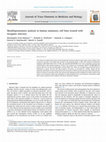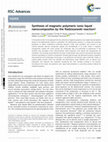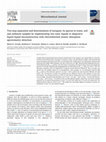Papers by Rodolfo Wuilloud
Journal of food measurement and characterization, Jan 27, 2024
Analytical and Bioanalytical Chemistry, Jan 19, 2024
Journal of Analytical Atomic Spectrometry, Mar 18, 2002
An on-line inorganic (InHg) and organomercury (OrHg) species separation, preconcentration and det... more An on-line inorganic (InHg) and organomercury (OrHg) species separation, preconcentration and determination system consisting of cold vapor atomic absorption spectrometry (CV-AAS) coupled to a flow injection (FI) method was studied. The inorganic mercury species was retained on a column (id, 3 mm; length, 80 mm) charged with a Dowex 1X-8 resin (particle size 50–100 mesh) as the anionic complex formed with Methylthymol Blue (MTB), at pH 6.3. Previous oxidation of the organomercurial species permitted the ...
Journal of Hazardous Materials, 2013
This article appeared in a journal published by Elsevier. The attached copy is furnished to the a... more This article appeared in a journal published by Elsevier. The attached copy is furnished to the author for internal non-commercial research and education use, including for instruction at the authors institution and sharing with colleagues. Other uses, including reproduction and distribution, or selling or licensing copies, or posting to personal, institutional or third party websites are prohibited. In most cases authors are permitted to post their version of the article (e.g. in Word or Tex form) to their personal website or institutional repository. Authors requiring further information regarding Elsevier's archiving and manuscript policies are encouraged to visit: http://www.elsevier.com/copyright

Talanta, Oct 15, 2009
An on-line retention and preconcentration system based on a sheep wool-packed microcolumn combine... more An on-line retention and preconcentration system based on a sheep wool-packed microcolumn combined with flame atomic absorption spectrometry is proposed for trace level determination of Cd in wine. A chelating reagent 2-(5-bromo-2-pyridylazo)-5-diethylaminophenol was immobilized onto the wool before retention of the analyte. Several factors influencing the preconcentration efficiency of Cd and his subsequent determination, such as pH, eluent type, sample and eluent flow rates, interfering effects, were studied. A preconcentration factor of 39 was obtained with only 20 mL of sample. The relative standard deviation for five determinations of 1 g L −1 Cd was 3.4%. The calibration graph was linear with a correlation coefficient of 0.998 at levels near the detection limit and up to at least 25 g L −1. The limit of detection was 37 ng L −1. The accuracy of the proposed methodology was tested by comparison of the results with those obtained by electrothermal atomic absorption spectrometry analysis along with a recovery study. Finally, the method was employed for evaluating Cd levels in different wines including, blank, rose, and red.

Journal of Trace Elements in Medicine and Biology, Mar 1, 2020
The interest in inorganic Hg toxicity and carcinogenicity has been pointed to target organs such ... more The interest in inorganic Hg toxicity and carcinogenicity has been pointed to target organs such as kidney, brain or placenta, but only a few studies have focused on the mammary gland. In this work, analytical combination techniques (SDS-PAGE followed by CV-AFS, and nanoUPLC-ESI-MS/MS) were used to determine proteins that could bind Hg in three human mammary cell lines. Two of them were tumorigenic (MCF-7 and MDA-MB-231) and the other one was the non-tumorigenic cell line (MCF-10A). There are no studies that provide this kind of information in breast cell lines with IHg treatment. Previously, we described the viability, uptake and the subcellular distribution of Hg in human breast cells and analysis of RNA-seq about the genes that encode proteins which are related to cytotoxicity of Hg. This work provides important protein candidates for further studies of Hg toxicity in the mammary gland, thus expanding our understanding of how environmental contaminants might affect tumor progression and contribute with future therapeutic methods.

RSC Advances, 2017
In the present article a new approach for the synthesis of magnetic polymeric ionic liquid nanoco... more In the present article a new approach for the synthesis of magnetic polymeric ionic liquid nanocomposites based on the Radziszewski reaction is presented. The Radziszewski reaction is a simple and successful procedure to obtain imidazolium-containing polymers under mild conditions and consists of the reaction between diamine compounds, glyoxal and formaldehyde in an acidic media. If magnetic nanoparticles coated with amino groups are introduced, they can participate as polyamines in the synthesis thus providing a final nanocomposite where polymeric ionic liquids and nanoparticles are combined. The resulting nanocomposite has been characterized using several instrumental techniques aimed at elucidating its chemical composition (infrared spectroscopy and elemental analysis), properties (zeta potential) and morphology (microscopy, X-ray diffraction and dynamic light scattering). Finally, its sorptive ability towards three non-steroidal anti-inflammatory drugs (NSAIDs) such as salicylic acid, ketoprofen and naproxen was evaluated considering the main variables involved in the process. According to the results, the polymeric ionic liquid nanocomposite is a promising sorptive material for analytical purposes.

Spectrochimica Acta Part B: Atomic Spectroscopy, Dec 1, 2019
Abstract A highly efficient magnetic dispersive micro-solid phase extraction (M-D-μSPE) method wa... more Abstract A highly efficient magnetic dispersive micro-solid phase extraction (M-D-μSPE) method was developed for Te preconcentration and speciation analysis in different environmental samples. A novel magnetic polymeric ionic liquid nanocomposite synthesized based on the Radziszewski reaction was applied for the selective retention of Te(IV) species, followed by elution with 5 mol L−1 HCl and determination by flow-injection hydride generation atomic fluorescence spectrometry. Te(VI) was selectively determined by difference between total Te and Te(IV) after a pre-reduction step. Studies on the sorption capacity of the nanocomposite were performed, while several parameters concerning the retention, separation and elution were optimized. A 100% retention efficiency and a sensitivity enhancement factor of 67 were achieved. Limits of detection of 1.9 ng L−1 and 3.7 ng L−1, and standard deviations of 4.3% and 5.1% were obtained for Te(IV) and Te(VI). A gas-liquid separator with a low dead volume was used for reduced dispersion of the flow injection signals and additional sensitivity enhancement. Finally, the feasibility of the proposed M-D-μSPE method for Te speciation was demonstrated by the analysis of several environmental samples, such as tap, rain, river and underground waters, soils and sediments, with excellent recovery results in spiked samples.
Talanta, May 1, 2020
Studying the effect of an ionic liquid on cloud point extraction technique for highly efficient p... more Studying the effect of an ionic liquid on cloud point extraction technique for highly efficient preconcentration and speciation analysis of tellurium in water, soil and sediment samples,

Microchemical Journal, Dec 1, 2020
A highly efficient liquid-liquid microextraction method based on two magnetic ionic liquids (MILs... more A highly efficient liquid-liquid microextraction method based on two magnetic ionic liquids (MILs) as extraction solvents for the determination of inorganic As species in water, soil and sediment samples, with electrothermal atomic absorption spectrometry detection, was developed. First, As(III) species was separated by chelation with ammonium pyrrolidine dithiocarbamate and then extracted by the MIL trihexyl(tetradecyl)phosphonium hexachlorodisprosiate ([P 6,6,6,14 ] 3 DyCl 6). The As(V) species remaining in the aqueous phase was preconcentrated by extraction in the MIL trihexyl(tetradecyl)phosphonium tetrachloroferrate ([P 6,6,6,14 ]FeCl 4) at 2 mol L-1 HCl. The MIL phase containing As(V) was separated by a magnetic rod and diluted in chloroform. Then, an aliquot was injected into the graphite furnace for As determination. Total inorganic As was determined using the MIL [P 6,6,6,14 ]FeCl 4 as the extraction solvent at 0.5 mol L-1 HCl to achieve the same extraction efficiency for both species. The concentration of As(III) was calculated by the difference between total inorganic As and As(V) concentration. An extraction efficiency of 99% for As(V) and an enhancement factor of 35 were obtained with 5 mL of sample. The method detection limits were 17 ng L-1 , 0.11 ng g −1 and 0.13 ng g −1 for As(V) and 20 ng L-1 , 0.13 ng g −1 and 0.14 ng g −1 for As(III) in water, soil and sediment samples, respectively. The relative standard deviations for six replicate measurements of 3 µg L-1 for As(V) and As(III) were 3.1% and 3.9% respectively. The calibration linear range was 0.05-13 µg L-1. The method was successfully applied for inorganic As species determination in water, soil and sediment samples. On the other hand, electrothermal atomic absorption spectrometry (ETAAS) has been widely used due to its simplicity, sensitivity, robustness and because it is less expensive than ICP-MS [1]. Likewise, ETAAS permits the direct injection of a few microliters of sample or

Spectrochimica Acta Part B: Atomic Spectroscopy, Jul 1, 2020
An analytical method based on the dispersive liquid-liquid microextraction (DLLME) technique, usi... more An analytical method based on the dispersive liquid-liquid microextraction (DLLME) technique, using a magnetic ionic liquid (MIL) as an extraction phase, was developed for ultra trace Cr determination in honey samples. The elemental detection was performed by electrothermal atomic absorption spectrometry (ETAAS). In the developed method both centrifugation and complexation of the analyte were not required. The Cr(III) species was extracted by the MIL trihexyl(tetradecyl)phosphonium ([P 6,6,6,14 ]FeCl 4) after the formation of [CrCl 2 (H 2 O) 4 ]Cl. The MIL phase was separated by a magnetic rod, diluted in CHCl 3 and Cr was determined by ETAAS. Under optimized experimental conditions, an extraction efficiency of 98% and a sensitivity enchancement factor of 105 were achieved. A detection limit (LOD) of 5 ng L −1 Cr and relative standard deviation of 3.5% (at 50 ng L −1 Cr and n = 10) were obtained. Also, the linear range of the calibration curve was from 15 ng L −1 to 180 ng L −1. The method was applied for Cr determination in honey samples of different shades.

Talanta, 2021
A novel on-line preconcentration and speciation analysis method for the simultaneous determinatio... more A novel on-line preconcentration and speciation analysis method for the simultaneous determination of inorganic Se and Te species is presented in this work. The methodology is based on the on-line formation of a hydrophobic ionic liquid (IL) directly in the liquid sample stream of a flow injection system, thus achieving an efficient and rapid extraction of the analytes complexed with ammonium pyrrolidine dithiocarbamate into the finely dispersed extractant droplets, that were then retained in a column filled with cotton. A full study of the chemical and hydrodynamical parameters was developed, including the right selection of the IL used as extractant and its concentration, pH, complexing reagent, sample and ion-exchange reagent volumes and column design. Additionally, a miniaturized external hydride generator was adapted to the spectrometer in order to increase the sensitivity of the atomic fluorescence measurements using only 250 μL of 5 mol L-1 HNO3 in methanol as eluent. The analytical figures of merit obtained for 15 mL of sample included sensitivity enhancement factors of 71, 70, 49 and 40 for Te(IV), Te(VI), Se(IV) and Se(VI), respectively, and limits of detection of 1.8 ng L-1 for both Te species, 2.6 ng L-1 for Se(IV) and 3.2 ng L-1 for Se(VI). After optimization, the method was successfully applied for the analysis of environmental samples: soils and sediments, as well as sea, river, underground and tap water.

Microchemical Journal, May 1, 2019
Abstract A highly sensitive and selective method based on dispersive micro-solid phase extraction... more Abstract A highly sensitive and selective method based on dispersive micro-solid phase extraction (D-μ-SPE) technique was developed for the determination of inorganic Se species. A very simple and fast preconcentration procedure involving the use of pure nanosilica for the extraction of Se(IV) complexed with ammonium pyrrolidine dithiocarbamate (APDC) was applied. Elution of the retained Se(IV) species from nanosilica was achieved with ethyl acetate followed by electrothermal atomic absorption spectrometry determination. For speciation analysis, Se(VI) was selectively quantified based on the difference between the concentrations of total inorganic Se and Se(IV) after a pre-reduction step. The interaction between the analyte and the extractant was characterized by FT-IR and an adsorption isotherm study. A 90% extraction efficiency was achieved after optimization of all factors concerning the extraction and elution steps, such as pH, ionic strength and type of chelating agent. Optimized conditions included pH = 2.0, 4.9 μmol L−1 APDC and the use of 1 mg nanosilica as adsorbent. A limit of detection of 1.4 ng L−1, a relative standard deviation of 4.8% and a 90-fold enhancement factor were obtained with 10 mL of sample. The developed method was finally applied to water samples from different origins and compositions, including rain, tap, underground, and sea.
Journal of Chromatography A, Sep 1, 2016
A comparative evaluation of different ionic liquids for arsenic species separation and determinat... more A comparative evaluation of different ionic liquids for arsenic species separation and determination in wine varietals by liquid chromatography-hydride generation atomic fluorescence spectrometry, Journal of Chromatography A
Journal of Chromatography A, Mar 1, 2017
Please cite this article in press as: A. Castro Grijalba, et al., Ionic liquid-assisted separatio... more Please cite this article in press as: A. Castro Grijalba, et al., Ionic liquid-assisted separation and determination of selenium species in food and beverage samples by liquid chromatography coupled to hydride generation atomic fluorescence spectrometry, J. Chromatogr.
Talanta, Jun 1, 2019
Determination of As in honey samples by magnetic ionic liquid-based dispersive liquid-liquid micr... more Determination of As in honey samples by magnetic ionic liquid-based dispersive liquid-liquid microextraction and electrothermal atomic absorption spectrometry, Talanta,
Spectrochimica Acta Part B: Atomic Spectroscopy, 2023
Journal of Analytical Atomic Spectrometry, 2020
Determination of As, Cd and Pb in food samples by means of inductively coupled plasma optical emi... more Determination of As, Cd and Pb in food samples by means of inductively coupled plasma optical emission spectrometry (ICP-OES) is challenging due to detection capabilities being close to the maximum levels established by current international food security policies. This work evaluates the benefits and drawbacks of knotted reactor extraction (KR) and dispersive liquid-liquid microextraction (DLLME) for the simultaneous ultratrace determination of the above-mentioned elements by ICP-OES. To this end, ICP-OES experimental conditions were optimized to minimize the negative effects of organics on plasma characteristics. Next, both KR and DLLME were optimized using experimental design for the simultaneous As, Cd and Pb preconcentration. KR










Uploads
Papers by Rodolfo Wuilloud